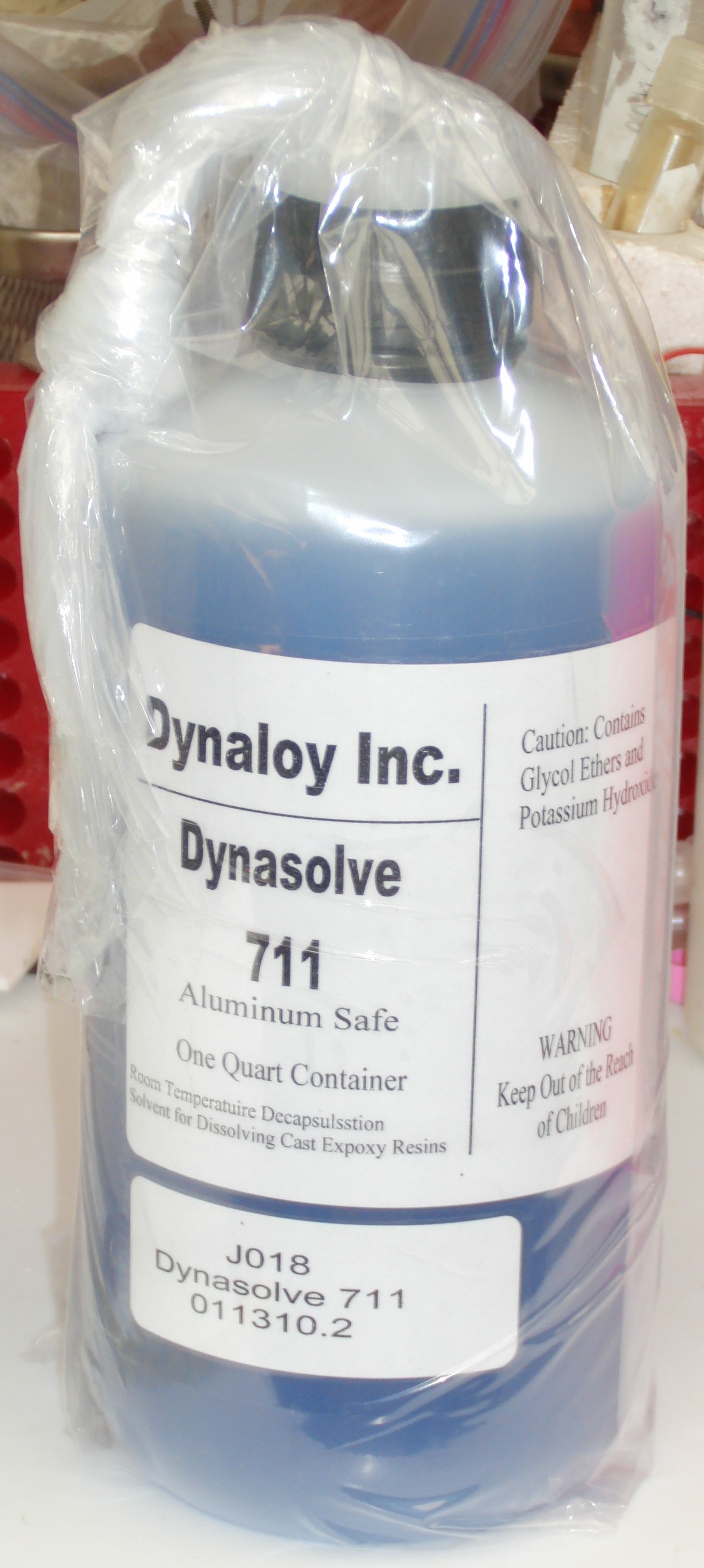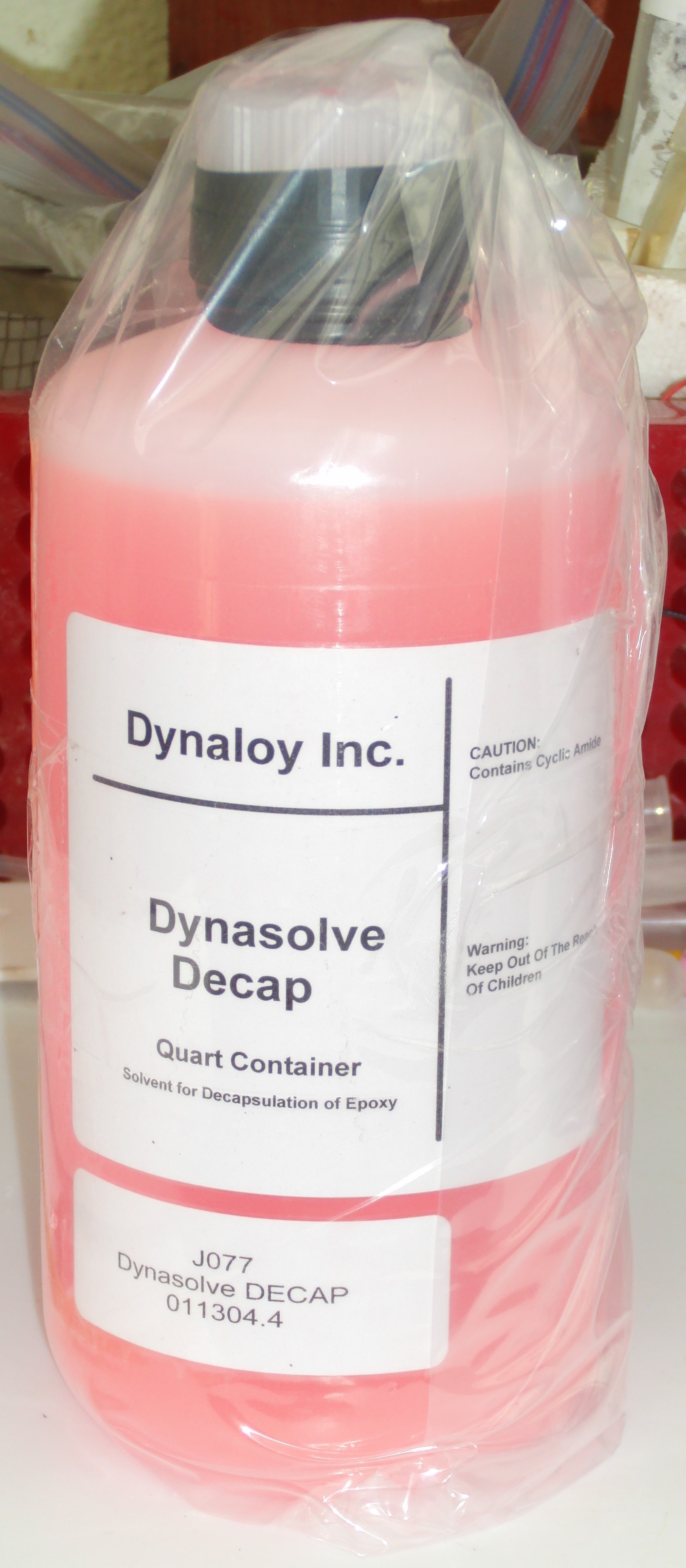Table of Contents
I tried decapping an MSP430 using both solvents and it didn't do a thing. I did some research on epoxy chemistry, looks like this probably only works against a very limited number of epoxies. Its nuclear how common these are.
DMSO
https://twitter.com/Zeptobars/status/1036864880857546753: “After 6 month testing my personal most promising solvent is DMSO. Will need to do more tests with heating and ultrasound to speed up the process.”
Dynaloy DYNASOLVE 711
2004-06-14: When I talked to a sales rep he said that most people use this over Dynaloy Decap these days for IC decapsulation. The main advantage is that it is supposed to be much nicer to aluminum (ie bond pads). It doesn't explicitly list IC decapsulation on the datasheet so I didn't consider ordering it.
06/14/2004 MSDS
| Chemical | CAS | Weight % |
|---|---|---|
| 2-PROPANOL, 1-METHOXY | 107-98-2 | 40-60 |
| 2-PROPANOL, 1-PHENOXY | 770-35-4 | 15-40 |
| 2-PYRROLIDINONE, 1-METHYL- | 872-50-4 | 15-35 |
| METHOL ALCOHOL | 67-56-1 | 2.5-10 |
| POTASSIUM HYDROXIDE | 1310-58-3 | 1-5 |
The KOH surprises me a little…maybe something else counteracts its effects on aluminum.
Dynaloy Decap
Advantages:
- Acid free decap (gentle on metals?)
- Datasheet claims it flakes, not swells. If so this makes it superior to swell epoxy removers which can damage bond wires
- Does not eat aluminum (or one should hope anyway since they say its fine to heat in an aluminum container…)
Disadvantages
- Expensive compared to simple acids (Ellsworth sells it from about $184-131 / quart)
- Must be used hot (150C)
IC package procedure [Dynaloy decap data sheet]:
- Pour into glass, stainless or aluminum beaker
- Heat to 150C. Do not heat further. Boils at 189C, flash point at 95C
- Use metal tongs to remove sample
- Wash sample with water, IPA, or MEK to remove Decap
Notes:
- To reuse: filter it
- Store above 70F as will crystalize below 60F. If so just re-heat
- Tarnishes silver and tinned leads
- Use rubber or polyethylene gloves
02/17/2009 MSDS
Comparing the datasheet I got in 2013 to the old datasheet I found online, it seems that they changed the product over time. This datasheet lists the following content:
| Chemical | CAS | Weight % |
|---|---|---|
| METHANE, SULFINYLBIS- (1) | 67-68-5 | 60-90 |
| 2-PROPANOL, 1-PHENOXY- | 770-35-4 | 10-30 |
Evidently the first is DMSO…never heard that name before
04/01/1993 MSDS
Content [Dynaloy decap MSDS]:
| Chemical | CAS | Weight % |
|---|---|---|
| AMYL ACETATE | 628-63-7 | 1-3% |
| METHYL SULFOXIDE, DIMETHYL SULFOXIDE | 67-68-5 | 80-90% |
| PROPYLENE GLYCOL PHENYL ETHER | 770-35-4 | 7-20% |
Resbond SSH13
This one might be only for non-molded epoxies (IE useless for IC work)
| Chemical | CAS | Weight % |
|---|---|---|
| Dichloromethane (DCM) | 75-09-2 | 75% |
| Formic acid | 64-18-6 | 10% |
| Phenol | 108-95-2 | 5% |
1,3-Dioxolane
“Many applications of dioxolane are due to its ability to rapidly dissolve polar polymers, such as polyesters, epoxies and urethanes.”
Pyridine and DMSO
Twitter: “Pyridine and DMSO, maybe 3:1 concentration, heated? This IBM patent suggested it”
References
- Dynaloy products: http://www.dynaloy.com/Products/epoxy_products.html
- Dynaloy decap MSDS: http://hazard.com/msds/f2/chm/chmhj.html
- Dynaloy decap data sheet]: http://www.dynaloy.com/images/stories/tech-briefs/Decap.pdf
- Dynaloy decap purchase: http://www.ellsworth.com/dynaloy-decap-degreaser-and-cleaner-1qt-bottle/

